
Cagliari is an Italian municipality and the capital of the island of Sardinia, an autonomous region of Italy. Cagliari's Sardinian name Casteddu means castle. It has about 155,000 inhabitants, while its metropolitan city has more than 431,000 inhabitants. According to Eurostat, the population of the Functional urban area, the commuting zone of Cagliari, rises to 476,975. Cagliari is the 26th largest city in Italy and the largest city on the island of Sardinia.
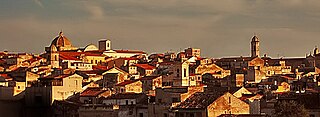
Sassari is an Italian city and the second-largest of Sardinia in terms of population with 127,525 inhabitants, and a Functional Urban Area of about 260,000 inhabitants. One of the oldest cities on the island, it contains a considerable collection of art.

Archaeological evidence of prehistoric human settlement on the island of Sardinia is present in the form of nuraghes and other prehistoric monuments, which dot the land. The recorded history of Sardinia begins with its contacts with the various people who sought to dominate western Mediterranean trade in classical antiquity: Phoenicians, Punics and Romans. Initially under the political and economic alliance with the Phoenician cities, it was partly conquered by Carthage in the late 6th century BC and then entirely by Rome after the First Punic War. The island was included for centuries in the Roman province of Sardinia and Corsica, which would be incorporated into the diocese of Italia suburbicaria in 3rd and 4th centuries.

The province of Carbonia-Iglesias was a province in the autonomous region of Sardinia, Italy. It included the historical area of Sulcis-Iglesiente and it was the smallest province of Sardinia. It is bordered by the provinces of Cagliari and Medio Campidano. All three provinces have been suppressed by the regional decree in 2016.
Sulci or Sulki, was one of the most considerable cities of ancient Sardinia, situated in the southwest corner of the island, on a small island, now called Isola di Sant'Antioco, which is, however, joined to the mainland by a narrow isthmus or neck of sand. South of this isthmus, between the island and the mainland, is an extensive bay, now called the Golfo di Palmas, which was known in ancient times as the Sulcitanus Portus (Ptol.).

Iglesias is a comune and city in the province of South Sardinia, Italy. It was co-capital of the province of Carbonia-Iglesias with Carbonia, and the province's second-largest community.
Mining and the processing of minerals date back to ancient times in Sardinia.

Carbonia is a town and comune in the Province of South Sardinia, Sardinia, Italy. Along with Iglesias it was a co-capital of the former province of Carbonia-Iglesias, now suppressed. It is located in the south-west of the island, at about an hour by car or train from the regional capital, Cagliari.

Arbus is a comune (municipality) in the Province of South Sardinia in the Italian region of Sardinia.

Buggerru is a comune (municipality) in the Province of South Sardinia in the Italian region Sardinia, located about 70 kilometres (43 mi) northwest of Cagliari and about 30 kilometres (19 mi) northwest of Carbonia.

Domusnovas, Domusnoas or Domus Noas in Sardinian language, is a comune (municipality) in the Province of South Sardinia in the Italian region Sardinia, located about 40 kilometres (25 mi) northwest of Cagliari and about 20 kilometres (12 mi) northeast of Carbonia, in the Sulcis-Iglesiente region, in the valley of the Cixerri river.

Fluminimaggiore is a comune (municipality) in the Province of South Sardinia in the Italian region Sardinia, located about 60 kilometres northwest of Cagliari and about 30 km (19 mi) north of Carbonia.
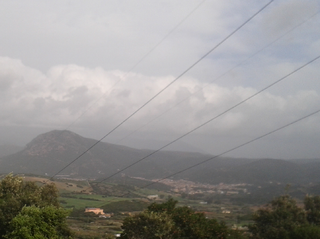
Gonnesa is a comune (municipality) in the Province of South Sardinia in the Italian region Sardinia, located about 60 kilometres (37 mi) west of Cagliari and about 14 kilometres (9 mi) northwest of Carbonia, in the Iglesiente subregion.
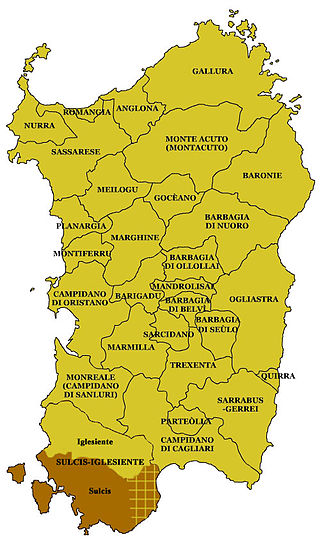
Sulcis is a subregion of Sardinia, Italy, in the Province of South Sardinia.

The Italian Catholic diocese of Iglesias is in Sardinia. It is a suffragan of the archdiocese of Cagliari.

Sardinia is the second largest island in the Mediterranean Sea and an autonomous region of Italy. Tourism in Sardinia is one of the fastest growing sectors of the regional economy. The island attracts more than a million tourists from both Italy, from the rest of Europe, and, to a lesser degree, from the rest of the world. According to statistics, tourist arrivals in 2016 were 2.9 million people.
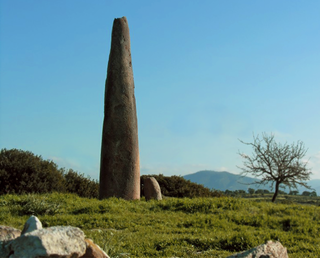
The Pre-Nuragic period refers to the prehistory of Sardinia from the Paleolithic until the middle Bronze Age, when the Nuragic civilization flourished on the island.

The Province of South Sardinia is an Italian province of Sardinia instituted on 4 February 2016. It includes the suppressed provinces of Carbonia-Iglesias and Medio Campidano, a large part of the old Province of Cagliari, and two other municipalities.
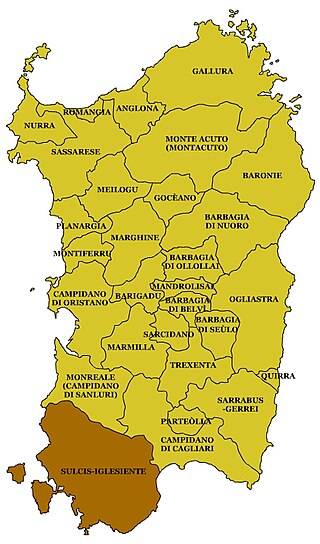
The Sulcis-Iglesiente is a historical region of southwestern Sardinia comprising, as the name suggests, the territories of Sulcis and Iglesiente. It is included in the province of South Sardinia.

















